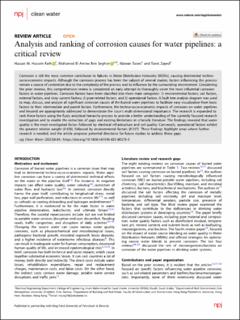| dc.contributor.author | Hussein Farh, Hassan M. | |
| dc.contributor.author | Seghier, Mohamed El Amine Ben | |
| dc.contributor.author | Taiwo, Ridwan | |
| dc.contributor.author | Tarek, Zayed | |
| dc.date.accessioned | 2024-01-19T08:32:15Z | |
| dc.date.available | 2024-01-19T08:32:15Z | |
| dc.date.created | 2023-12-18T13:52:27Z | |
| dc.date.issued | 2023 | |
| dc.identifier.citation | npj Clean Water. 2023, 6 . | en_US |
| dc.identifier.uri | https://hdl.handle.net/11250/3112666 | |
| dc.description.abstract | Corrosion is still the most common contributor to failures in Water Distribution Networks (WDNs), causing detrimental technosocio-economic impacts. Although the corrosion process has been the subject of several studies, factors influencing this process remain a source of contention due to the complexity of the process and its influence by the surrounding environment. Considering the prior reviews, this comprehensive review is considered an early attempt to thoroughly cover the most influential corrosion factors in water pipelines. Corrosion factors have been classified into three main categories: 1) environmental factors; soil factors, external factors, and stray current factors; 2) pipe-related factors, and 3) operational factors. A fault tree analysis diagram was used to map, discuss, and analyze all significant corrosion causes of the buried water pipelines to facilitate easy visualization from basic factors to their intermediate and parent factors. Furthermore, the techno-socio-economic impacts of corrosion on water pipelines and beyond are appropriately addressed to demonstrate the issue’s multi-dimensional importance. The research is expanded to rank these factors using the fuzzy analytical hierarchy process to provide a better understanding of the currently focused research investigation and to enable the extraction of gaps and existing limitations in scholarly literature. The findings revealed that water quality is the most investigated factor, followed by electrical infrastructure and soil quality. Conversely, operational factors exhibit the greatest relative weight (0.428), followed by environmental factors (0.337). These findings highlight areas where further research is needed, and the article proposes potential directions for future studies to address these gaps | en_US |
| dc.language.iso | eng | en_US |
| dc.rights | Navngivelse 4.0 Internasjonal | * |
| dc.rights.uri | http://creativecommons.org/licenses/by/4.0/deed.no | * |
| dc.title | Analysis and ranking of corrosion causes for water pipelines: a critical review | en_US |
| dc.type | Peer reviewed | en_US |
| dc.type | Journal article | en_US |
| dc.description.version | publishedVersion | en_US |
| cristin.ispublished | true | |
| cristin.fulltext | original | |
| cristin.qualitycode | 1 | |
| dc.identifier.doi | 10.1038/s41545-023-00275-5 | |
| dc.identifier.cristin | 2214921 | |
| dc.source.journal | npj Clean Water | en_US |
| dc.source.volume | 6 | en_US |
| dc.source.pagenumber | 17 | en_US |

